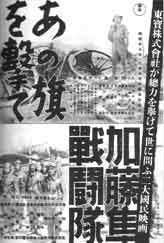Ano hata o ute
6 /10 1 Votes
Duration | Language Japanese | |||||||||||||||||||||||||||||||||
 | ||||||||||||||||||||||||||||||||||
Writer Yagi Koichiro , Oguni Hideo Release date February 10, 1944 | ||||||||||||||||||||||||||||||||||
Ano hata o ute (あの旗を撃て−コレヒドールの最後−) (Filipino: Liwayway ng Kalayaan) aka Dawn of Freedom, aka Fire on that Flag: The End of Corregidor is a 1943 black-and-white Japanese film directed by Yutaka Abe and Gerardo de León.
Contents
Synopsis
Opening credits starts as the narrator speaking about in December 8, 1941 Japan, is accepting the challenge of the Western powers rises in arms after having had to stand by for years watching rapacious America and Britain tread upon the enslaved peoples of East Asia . Japan expeditionary forces are rushed to various places in the vast areas of Greater East Asia in order to drive out the Western powers. The first blow in the Philippines is death when Nippon warplanes raid Clark Air Base and Iba airfield on December 8.
The story of the Japanese victory at the Battle of Corregidor and the U.S. military's hasty retreat from the islands. The film presented the Japanese as Asian liberators who came to free the Filipinos from decades of colonial oppression at the same time Sub corporal Ikejima (Heihachiro Okawa) helped the boy named Toni (Ricardo Pasion) which is a younger brother of Capt. Garcia (Fernando Poe Sr.) to walk again after a car accident.
About the Film
The film was premiered in Tokyo on February 5, 1944. Originally entitled Mito Sakusan (Philippine Operation), it was changed to Ano Hatte O Utte or literally, “Tear down the Stars and Stripes.” For the Philippines, it was decided to use The Dawn of Freedom or Liwayway ng Kalayaan.
The making of the movie had gone into controversies such as, using Filipino and American POW's as extras along with the Filipino which is invited or coerced them into work along with the Japanese actors specially in the scene where the photograph under the ad copy shows two Japanese soldiers holding a group of Filipinos at bay under gun point. Without seeing the film, one would not know the Filipinos were thieves caught by vigilant Japanese soldiers protecting the local population. Whether wittingly or not, the advertisement throws the terms of this "co-production" into question, This was how the Japanese producers formed the all-star cast and crew for The Dawn of Freedom.
The Dawn of freedom is most effective Japanese films from the Pacific War, however, the historian is always hard-put to research how a film was received upon its release. The documents available as avenues to the past are difficult to trust. and there is always some measure of speculation mixed with one's analysis. Our approach to The Daunt of Freedom's spectators in the past might take three very different paths: film criticism, studio records, and the film itself.
Cast and Staffs
Staff
Availability
Dawn of freedom was released in DVD on January 20, 2015 by Deagostini .
References
Ano hata o ute WikipediaAno hata o ute IMDb
